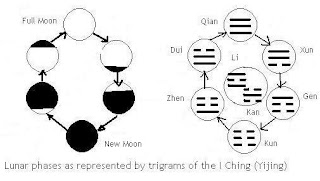Moon Phases and Trigrams in the I Ching
There will be a new moon this Saturday, and it is also the Chinese Lunar New Year, so some moon information seemed appropriate.
This diagram shows how the trigrams of the I Ching can be used as symbols for the yin and yang of the light of the moon as it passes through its phases. Beginning at the bottom with the New Moon, follow the trigrams on the right through the moon phases on the left in a clock-wise direction.
The New Moon is most yin, dark and invisible, so its symbol is Kun, made of three yin/dark/broken lines. Circling upward to the left, the light of the crescent waxing moon is symbolized by the bottom yang/light/solid line of the trigram Zhen. Dui, the trigram of bottom and middle yang lines and top yin line, represents the waxing gibbous moon phase. At the top, the three yang/light lines of Qian as the Full Moon keep the darkness of night at bay.
As the moon wanes, the darkness creeps in as shown in the lower line of Xun in the waning gibbous phase. The waning crescent that is two-thirds dark is represented by the two yin/dark lower lines of the trigram Gen. Coming full cycle, we arrive back at Kun and the next new moon.
Below is a photo from Wikipedia showing some of the figures found in a Full Moon, followed by some Chinese Moon Myths.
The rabbit is a popular lunar creature. Some folkloric paintings show Chang-E [moon goddess] clutching the furry creature as she floats to the sky. Legend has it that her husband, divine archer Hou Yi, summoned the rabbit to be his wife's companion for those lonely days at the cold moon palace. She rose to the moon after drinking a magic potion and became an immortal.
Matchmaker Yuexialaoyren is "the old man in the moon." Many tourists, young couples especially, adore posing with his sculpture in
The eclipse of the moon was a bad celestial sign in the old days. The Chinese believed that the Heavenly Dog was trying to eat up the moon. They would beat drums and gongs to scare the dog away.
HAPPY NEW YEAR!!!


No comments:
Post a Comment